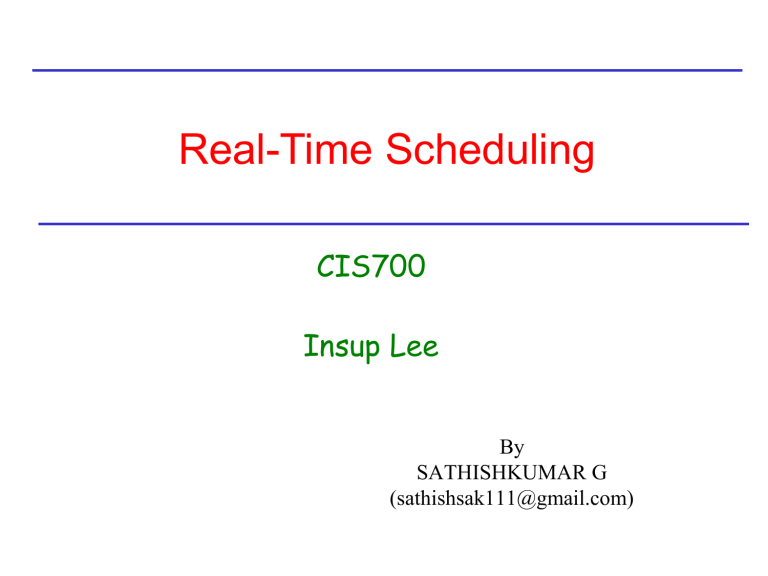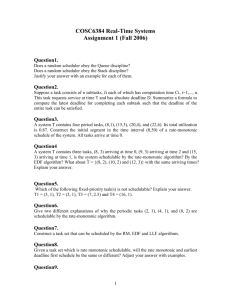
Real-Time Scheduling
CIS700
Insup Lee
By
SATHISHKUMAR G
(sathishsak111@gmail.com)
Outline
• Real-time systems
• Real-time scheduling algorithms
– Fixed-priority algorithm (RM)
– Dynamic-priority algorithm (EDF)
Real-Time Systems
• Definition
– Systems whose correctness depends on their temporal
aspects as well as their functional aspects
• Performance measure
– Timeliness on timing constraints (deadlines)
– Speed/average case performance are less significant.
• Key property
– Predictability on timing constraints
Real-Time System Example
• Digital control systems
– periodically performs the following job:
senses the system status and
actuates the system according to its current status
Control-Law
Computation
Sensor
Actuator
Real-Time System Example
• Multimedia applications
– periodically performs the following job:
reads, decompresses, and displays video and audio
streams
Multimedia
Fundamental Real-Time Issue
• To specify the timing constraints of real-time
systems
• To achieve predictability on satisfying their timing
constraints, possibly, with the existence of other
real-time systems
Scheduling Framework Example
Digital Controller
Multimedia
OS Scheduler
CPU
Real-Time Workload
• Job (unit of work)
– a computation, a file read, a message transmission, etc
• Attributes
– Resources required to make progress
– Timing parameters
Released
Execution time
Relative deadline
Absolute
deadline
Real-Time Task
• Task : a sequence of similar jobs
– Periodic task (p,e)
•
•
•
•
0
Its jobs repeat regularly
Period p = inter-release time (0 < p)
Execution time e = maximum execution time (0 < e < p)
Utilization U = e/p
5
10
15
Deadlines: Hard vs. Soft
• Hard deadline
– Disastrous or very serious consequences may occur if
the deadline is missed
– Validation is essential : can all the deadlines be met,
even under worst-case scenario?
– Deterministic guarantees
• Soft deadline
– Ideally, the deadline should be met for maximum
performance. The performance degrades in case of
deadline misses.
– Best effort approaches / statistical guarantees
Schedulability
• Property indicating whether a real-time system (a set
of real-time tasks) can meet their deadlines
(4,1)
(5,2)
(7,2)
Real-Time Scheduling
• Determines the order of real-time task executions
• Static-priority scheduling
• Dynamic-priority scheduling
(4,1)
(5,2)
(7,2)
5
10
15
5
10
15
RM (Rate Monotonic)
•
•
•
•
Optimal static-priority scheduling
It assigns priority according to period
A task with a shorter period has a higher priority
Executes a job with the shortest period
T1 (4,1)
T2 (5,2)
T3 (7,2)
5
10
15
5
10
15
RM (Rate Monotonic)
• Executes a job with the shortest period
T1 (4,1)
T2 (5,2)
T3 (7,2)
5
10
15
5
10
15
RM (Rate Monotonic)
• Executes a job with the shortest period
Deadline Miss !
T1 (4,1)
T2 (5,2)
T3 (7,2)
5
10
15
5
10
15
Response Time
• Response time
– Duration from released time to finish time
T1 (4,1)
T2 (5,2)
T3 (10,2)
5
10
15
5
10
15
Response Time
• Response time
– Duration from released time to finish time
Response Time
T1 (4,1)
T2 (5,2)
T3 (10,2)
5
10
15
5
10
15
Response Time
• Response Time (ri) [Audsley et al., 1993]
ri
ri = ei + ∑ ⋅ ek
Tk∈HP (Ti ) pk
•
HP(Ti) : a set of higher-priority tasks than Ti
T1 (4,1)
T2 (5,2)
T3 (10,2)
5
10
5
10
RM - Schedulability Analysis
• Real-time system is schedulable under RM
if and only if ri ≤ pi for all task Ti(pi,ei)
Joseph & Pandya,
“Finding response times in a real-time system”,
The Computer Journal, 1986.
RM – Utilization Bound
• Real-time system is schedulable under RM if
∑Ui ≤ n (21/n-1)
Liu & Layland,
“Scheduling algorithms for multi-programming in a
hard-real-time environment”, Journal of ACM, 1973.
RM – Utilization Bound
• Real-time system is schedulable under RM if
∑Ui ≤ n (21/n-1)
• Example: T1(4,1), T2(5,1), T3(10,1),
∑Ui = 1/4 + 1/5 + 1/10
= 0.55
3 (21/3-1) ≈ 0.78
Thus, {T1, T2, T3} is schedulable under RM.
RM – Utilization Bound
• Real-time system is schedulable under RM if
∑Ui ≤ n (21/n-1)
RM Utilization Bounds
Utilization
1.1
1
0.9
0.8
0.7
0.6
0.5
1
4
16
64
256
1024 4096
The Number of Tasks
EDF (Earliest Deadline First)
• Optimal dynamic priority scheduling
• A task with a shorter deadline has a higher priority
• Executes a job with the earliest deadline
T1 (4,1)
T2 (5,2)
T3 (7,2)
5
10
15
5
10
15
EDF (Earliest Deadline First)
• Executes a job with the earliest deadline
T1 (4,1)
T2 (5,2)
T3 (7,2)
5
10
15
5
10
15
EDF (Earliest Deadline First)
• Executes a job with the earliest deadline
T1 (4,1)
T2 (5,2)
T3 (7,2)
5
10
15
5
10
15
EDF (Earliest Deadline First)
• Executes a job with the earliest deadline
T1 (4,1)
T2 (5,2)
T3 (7,2)
5
10
15
5
10
15
EDF (Earliest Deadline First)
• Optimal scheduling algorithm
– if there is a schedule for a set of real-time tasks,
EDF can schedule it.
T1 (4,1)
T2 (5,2)
T3 (7,2)
5
10
15
5
10
15
Processor Demand Bound
• Demand Bound Function : dbf(t)
– the maximum processor demand by workload over any
interval of length t
t
T1 (4,1)
T2 (5,2)
T3 (7,2)
5
10
15
5
10
15
EDF - Schedulability Analysis
• Real-time system is schedulable under EDF
if and only if dbf(t) ≤ t for all interval t
Baruah et al.
“Algorithms and complexity concerning the preemptive
scheduling of periodic, real-time tasks on one
processor”, Journal of Real-Time Systems, 1990.
• Demand Bound Function : dbf(t)
– the maximum processor demand by workload over any
interval of length t
EDF – Utilization Bound
• Real-time system is schedulable under EDF if and only
if
∑Ui ≤ 1
Liu & Layland,
“Scheduling algorithms for multi-programming in a
hard-real-time environment”, Journal of ACM, 1973.
EDF – Overload Conditions
• Domino effect during overload conditions
– Example: T1(4,3), T2(5,3), T3(6,3), T4(7,3)
Deadline Miss !
T1
T2
0
T3 T4
3
5
6
7
Better schedules :
T1
0
T3
3
T1
5
6
7
0
T4
3
5
6
7
RM vs. EDF
• Rate Monotonic
– Simpler implementation, even in systems without explicit
support for timing constraints (periods, deadlines)
– Predictability for the highest priority tasks
• EDF
– Full processor utilization
– Misbehavior during overload conditions
• For more details: Buttazzo, “Rate monotonic vs. EDF:
Judgement Day”, EMSOFT 2003.
T
Y
K
N
HA
U
O


